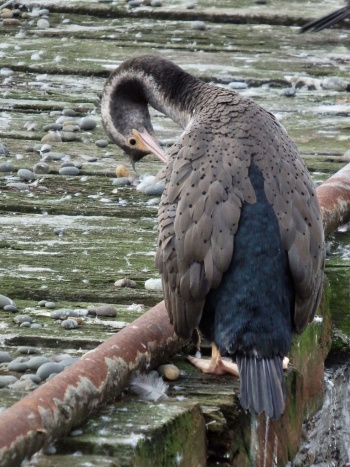- Phalacrocorax punctatus
Stictocarbo punctatus
Identification
64–74 cm (25¼-29 in).
Compared with typical cormorants, the Spotted Shag is a light-coloured bird.
Its back is brown. Its belly is pale blue-grey (often appearing white), and the white continues up the sides of the neck and face, but the throat and the top of the head are dark blue-green.
In the mating season, it has an obvious double crest.
There is little sexual dimorphism.
Distribution
New Zealand endemic.
Taxonomy
Subspecies
P. p. punctatus:
- North Island and South Island (New Zealand)
P. p. oliveri:
- Stewart Island and adjacent western coast of South Island (New Zealand)
Habitat
Marine birds, coastal cliffs or on rocky islets. They forage in fairly deep water, up to 16km off shore.
Behaviour
Breeding
They nest in colonies of 10-700 pairs on ledges of cliffs. The nest is a platform about 0.6m across made of seaweed, grass and iceplants. The clutch of 1 – 4 pale blue eggs is incubated for 28 – 35 days. The chicks fledge at 57 – 71 days. The young are fed by both parents while in the nest.
Diet
There is very little detailed information. Their diet is thought to consist of small fish and crustaceans. They hunt by pursuit diving. They can form large feeding flocks.
References
- Clements, J. F., T. S. Schulenberg, M. J. Iliff, D. Roberson, T. A. Fredericks, B. L. Sullivan, and C. L. Wood. 2018. The eBird/Clements checklist of birds of the world: v2018. Downloaded from http://www.birds.cornell.edu/clementschecklist/download/
- Orta, J., Jutglar, F., Garcia, E.F.J., Kirwan, G.M. & Boesman, P. (2017). Spotted Shag (Phalacrocorax punctatus). In: del Hoyo, J., Elliott, A., Sargatal, J., Christie, D.A. & de Juana, E. (eds.). Handbook of the Birds of the World Alive. Lynx Edicions, Barcelona. (retrieved from http://www.hbw.com/node/52657 on 3 February 2017).
- Marchant, S. & Higgins, P.J. (co-ordinating editors) 1990. Handbook of Australian, New Zealand & Antarctic Birds. Volume 1, Ratites to ducks; Part B, Australian pelican to ducks. Melbourne, Oxford University Press. Pages 737, 808-809, 838-844; plate 62.
- Szabo, M.J. 2013 [updated 2015]. Spotted shag. In Miskelly, C.M. (ed.) New Zealand Birds Online. http://www.nzbirdsonline.org.nz
Recommended Citation
- BirdForum Opus contributors. (2024) Spotted Shag. In: BirdForum, the forum for wild birds and birding. Retrieved 11 May 2024 from https://www.birdforum.net/opus/Spotted_Shag






